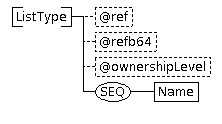 | Cloud Fax and Notifications API 2.6 Documentation Common Types and Elements | Cloud Fax and Notifications API Forums Home |
3.9.9 ListType
The List destination refers to a list of destinations stored on the switch. There are multiple list stores - lists stored in XDDS switches are distinct from lists stored in MR (messageREACH®) switches (even though the same list names might be used.) When a list is used for a delivery job, the list is expected to exist in the list store of the switch processing the job, which (for the API) is determined by the option set in the JobSubmit request. See JobSubmit Overview for more information. Generally jobs with fax, voice, mailmerge and simple email deliveries uses XDDS switches, and enhanced email and SMS deliveries use MR switches.

| Tag Name & type | # | Description | |||||
|---|---|---|---|---|---|---|---|
| ListType | |||||||
| @ref xs:string | 0-1 | Identifier for this destination. This can appear on reports, and should generally be kept short. | |||||
| @refb64 xs:string | 0-1 | Base64-encoded identifier for this destination. This is an alternative to ref when applications may require data incompatible with the XML document. | |||||
| @ownershipLevel OwnershipLevelType | 0-1 | Indicates the ownership level of the list, which may be necessary to disambiguate the name. Legal values are:
| |||||
| Name xs:string | 1 | The name of the list. Although use of the ownershipLevel attribute is preferred, the ownership level can be indicated by a prefix character in the list name itself ('!', '@', '#', '$'). To be sure of avoiding misinterpretation, lists should not be given actual names that begin with these characters. List names are expected to be relatively short and simple. They are currently limited to 38 bytes. Names are most reliable if they contain only ASCII alphanumeric characters and '_'. However, other characters may be used (although a test is advisable), and the API will attempt to convert names provided in requests to the user's configured character set. | |||||
| © Copyright 2020 OpenText Corp. All Rights Reserved. Privacy Policy | Cookie Policy |
This information is subject to change. Please check frequently for updates. Modified October 06, 2020 |